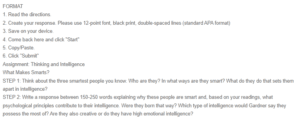Thinking and Intelligence – What Makes Smarts?
The concept of intelligence is a multifaceted and intriguing aspect of human cognition. It encompasses various dimensions, including cognitive, emotional, and creative intelligence, each contributing to what we perceive as “smart” (Sternberg, 2019). Among the smartest people I know, three individuals exhibit remarkable qualities. John, an astrophysicist, possesses exceptional problem-solving skills, showcasing high cognitive intelligence. Jane, a therapist, is renowned for her empathetic understanding of people’s emotions, representing a remarkable display of emotional intelligence. Lastly, Mark, a successful entrepreneur, is celebrated for his innovative thinking and creative business strategies, highlighting his creative intelligence.
The age-old question of whether intelligence is an innate quality or a nurtured one has intrigued psychologists and educators. While some may argue that these individuals were born with their intelligence, there is substantial evidence that their experiences and nurturing played a significant role in shaping their minds. John’s early exposure to astrophysical concepts and access to educational resources nurtured his cognitive intelligence. Jane’s upbringing, emphasizing empathy and understanding, cultivated her emotional intelligence. Mark’s diverse experiences and challenges in the business world fostered his creativity and problem-solving skills.
Howard Gardner’s theory of multiple intelligences broadens our understanding of intelligence, suggesting that there are several types of intelligence. John’s expertise in astrophysics aligns with logical-mathematical intelligence, while Jane’s ability to connect with her clients reflects interpersonal intelligence. Mark’s entrepreneurial ventures draw upon elements of spatial and intrapersonal intelligence, reflecting his adaptability and self-awareness. Emotional intelligence, a pivotal facet of human intelligence, is particularly evident in Jane’s role as a therapist. She possesses the ability to accurately perceive emotions, effectively manage her own, and empathize with her clients’ experiences. This emotional intelligence not only enhances her professional success but also contributes to her overall intelligence by enabling her to navigate complex social situations with ease.
The relationship between creativity and intelligence is equally intriguing. Mark’s creative approach to business challenges demonstrates the fusion of these two attributes. His innovative thinking is not only a product of cognitive intelligence but also an expression of his creative mind. This dynamic synergy results in his exceptional problem-solving abilities and innovative business strategies.
Reference
Sternberg, R. J. (2019). The concept of intelligence. The Cambridge Handbook of Intelligence, 3–17. https://doi.org/10.1017/9781108770422.002
ORDER A PLAGIARISM-FREE PAPER HERE
We’ll write everything from scratch
Question

Discussion – Thinking and Intelligence
FORMAT
1. Read the directions.
2. Create your response. Please use 12-point font, black print, double-spaced lines (standard APA format)
3. Save on your device.
4. Come back here and click “Start”
5. Copy/Paste.
6. Click “Submit”
Assignment: Thinking and Intelligence
What Makes Smarts?
STEP 1: Think about the three smartest people you know. Who are they? In what ways are they smart? What do they do that sets them apart in intelligence?
STEP 2: Write a response between 150-250 words explaining why these people are smart and, based on your readings, what psychological principles contribute to their intelligence. Were they born that way? Which type of intelligence would Gardner say they possess the most of? Are they also creative or do they have high emotional intelligence?

